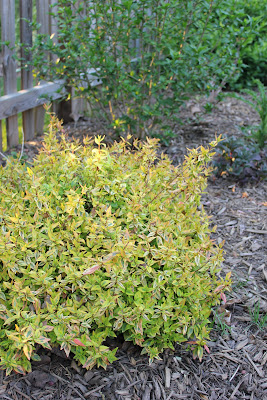Damn good plants - Abelia Kaleidoscope
 |
| Late March 2012 |
Now I’m not particularly partial to variegated plants due to
there over use at drive thru’s or theme parks but this little guy made me reconsider
my snobby ways. Its bright demeanor during
the winter causes a pause while walking the dog around and has remained a
reliable evergreen even in our harshness winters of ‘09 and ‘10 (remember snow-mega
ding!). The foliage colors change with varying degrees
of saturation at different times of year with the most dazzling performance
being saved for late fall into winter with highlights of fiery reds and oranges
overlaid the normal greens and yellows.
A common problem with most variegated plants is the habit of reversion,
where plain green stems appear and begin to dominate unless pruned off. So far this hasn’t been a concern for mine.
Glossy Abelia’s are well known for their long bloom time,
starting in Northern Virginia from mid-July
through to first frost. On
‘Kaleidoscope’ there is no exception, adorned with soft white trumpet like
flowers although the foliage still steals the show from a distance. Its low profile of up to 2 ½ ft in height
makes it a useful foreground shrub to capture the eye and design out from. A word of warning, more doesn’t mean better
as it will distracted the eye and prevent it from moving around the landscape,
a common problem with any variegated plant in mass. If this is the desired look, then make sure
you place other variegated plants in difference locations around the landscape
so that the eye can hop from one bright spot to another.
Pests, diseases, drought, sun and shade, unfazed to anything
you can throw at it. The only con’ I’ve
found is that its rooting is slow resulting in nurseries pushing stock that aren’t
‘can full’ rooted, but this doesn’t even seem to ruffle its feathers. Some nurseries will hold onto stock a little
longer to provide a stronger rooted plant but this does raise the cost of
production but all benefits the consumer in the long run.